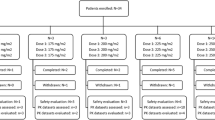Summary
Background K-912 also known as NC-6300 is a novel epirubicin pro-drug conjugate developed using micellar nanoparticle technology. We conducted a first-in-human, Phase 1, open-label, non-randomized dose escalation study to evaluate the safety, tolerability, efficacy, and pharmacokinetics of K-912 administered as monotherapy in patients with advanced or recurrent solid tumors. Methods Patients aged 41 to 72 years with histologically or cytologically confirmed advanced or recurrent malignant solid tumors either refractory to standard therapy or had no other viable treatment options were enrolled. K-912 was administered as a 10-min intravenous infusion every three weeks. Doses were increased in a step-wise manner based on a predetermined series: 15, 30, 60, 80, 100, 130, 170, and 225 mg/m2. The appropriateness of doses above 60 mg/m2 was assessed using a Bayesian continual reassessment model. Treatment-emergent adverse events and tumor response were evaluated according to internationally accepted criteria. Results Nineteen patients were treated with K-912. No additional adverse events expected with anthracyclines were observed. While the number of patients treated at the maximum tolerated dose (MTD) and the recommended phase 2 dose (RP2D) were small, MTD and RP2D were established to be 170 mg/m2. Partial response was observed in one patient with breast cancer treated at 100 mg/m2, yielding an objective response rate of 5% (1/19). Stable disease was observed in 10 patients. The human pharmacokinetic profile of K-912 was consistent with that observed from nonclinical studies in rats and monkeys. Conclusions This study showed that K-912 was well tolerated in patients with various solid tumors and exhibited less toxicity than conventional epirubicin formulations.



Similar content being viewed by others
References
Maeda H, Matsumura Y (1989) Tumoritropic and lymphotropic principles of macromolecular drugs. Crit Rev Ther Drug Carrier Syst 6:193–210
Matsumura Y, Maruo K, Kimura M, Yamamoto T, Konno T, Maeda H (1991) Kinin-generating cascade in advanced cancer patients and in vitro study. Jpn J Cancer Res 82:732–741
Bae Y, Nishiyama N, Fukushima S, Koyama H, Matsumura Y, Kataoka K (2005) Preparation and biological characterization of polymeric micelle drug carriers with intracellular pH-triggered drug release property: tumor permeability, controlled subcellular drug distribution, and enhanced in vivo antitumor efficacy. Bioconjug Chem 16:122–130
Matsumura Y, Kataoka K (2009) Preclinical and clinical studies of anticancer agent-incorporating polymer micelles. Cancer Sci 100:572–579
Fujiwara A, Hoshino T (1985) Anthracycline antibiotics. Crit Rev Biotechnol 3:133–157. doi:10.3109/07388558509150782
Von Hoff DD, Layard MW, Basa P, Davis HL Jr, Von Hoff AL, Rozencweig M, Muggia FM (1979) Risk factors for doxorubicin-induced congestive heart failure. Ann Intern Med 91:710–717
Swain SM, Whaley FS, Ewer MS (2003) Congestive heart failure in patients treated with doxorubicin: a retrospective analysis of three trials. Cancer 97:2869–2879
Rahman AM, Yusuf SW, Ewer MS (2007) Anthracycline-induced cardiotoxicity and the cardiac-sparing effect of liposomal formulation. Int J Nanomedicine 2:567–583
(2014) Farmorubicin® for Injection 10 mg and 50 mg [package insert, in Japanese], 8th edn. Pfizer Japan Inc., Tokyo
(2014) Farmorubicin® RTU Injection 10 mg and 50 mg [package insert, in Japanese], 7th edn. Pfizer Japan Inc., Tokyo
(2014) Epirubicin Hydrochloride Injection 10 mg/5 mL and 50 mg/25 mL Sawai [package insert, in Japanese], 2nd edn. Sawai Pharmaceutical Co., Ltd., Osaka
(2014) Epirubicin Hydrochloride for Injection 10 mg and 50 mg Sawai [package insert, in Japanese], 4th edn. Sawai Pharmaceutical Co., Ltd., Osaka
(2015) Epirubicin Hydrochloride Injection 10 mg/5 mL and 50 mg/25 mL Sandoz [package insert, in Japanese], 3rd edn. Sandoz K. K., Tokyo
(2014) Epirubicin Hydrochloride Injection 10 mg/5 mL and 50 mg/25 mL Hospira [package insert, in Japanese], 2nd edn. Mochida Pharmaceutical Co., Ltd., Tokyo
(2014) Epirubicin Hydrochloride Injection 10 mg/5 mL and 50 mg/25 mL NK [package insert, in Japanese], 5th edn. Nippon Kayaku Co., Ltd., Tokyo
(2014) Epirubicin Hydrochloride for Injection 10 mg and 50 mg NK [package insert, in Japanese], 13th edn. Nippon Kayaku Co., Ltd., Tokyo
(2014) Epirubicin Hydrochloride for Injection 10 mg and 50 mg NK [package insert, in Japanese], 10th edn. Mylan Seiyaku Ltd., Tokyo
Harada M, Bobe I, Saito H, Shibata N, Tanaka R, Hayashi T, Kato Y (2011) Improved anti-tumor activity of stabilized anthracycline polymeric micelle formulation, NC-6300. Cancer Sci 102:192–199
Takahashi A, Yamamoto Y, Yasunaga M, Koga Y, Kuroda J, Takigahira M, Harada M, Saito H, Hayashi T, Kato Y, Kinoshita T, Ohkohchi N, Hyodo I, Matsumura Y (2013) NC-6300, an epirubicin-incorporating micelle, extends the antitumor effect and reduces the cardiotoxicity of epirubicin. Cancer Sci 104:920–925
(2011) ELLENCE® (epirubicin hydrochloride injection) [package insert]. Pharmacia & Upjohn Co, Division of Pfizer Inc., New York
Clark AS, Vahdat LT (2004) Chemotherapy-induced palmar-plantar erythrodysesthesia syndrome: etiology and emerging therapies. Support Cancer Ther 1:213–218. doi:10.3816/SCT.2004.n.013
Acknowledgements
This study was funded by Kowa Company, Ltd.
Author information
Authors and Affiliations
Corresponding author
Ethics declarations
Conflict of interest
This study was sponsored by Kowa Company, Ltd., Aichi, Japan.
Ethical approval
Prior to the study, the Institutional Review Board at the National Cancer Center Hospital East approved the protocol and the informed consent document. Written informed consent was obtained from all patients enrolled into the study. Patients starting the second and subsequent courses of treatment provided their written re-consent. This study was conducted in accordance with the protocol, International Conference on Harmonization (ICH) Good Clinical Practice guidelines, the Declaration of Helsinki, and all applicable local and national legislation.
Additional information
Trial registry number: JapicCTI-132221
Rights and permissions
About this article
Cite this article
Mukai, H., Kogawa, T., Matsubara, N. et al. A first-in-human Phase 1 study of epirubicin-conjugated polymer micelles (K-912/NC-6300) in patients with advanced or recurrent solid tumors. Invest New Drugs 35, 307–314 (2017). https://doi.org/10.1007/s10637-016-0422-z
Received:
Accepted:
Published:
Issue Date:
DOI: https://doi.org/10.1007/s10637-016-0422-z




